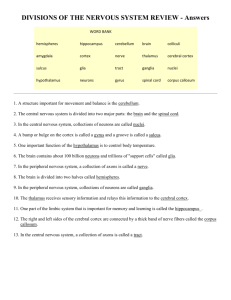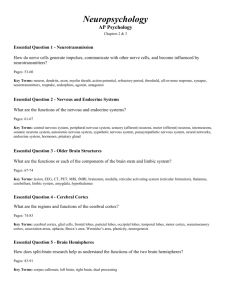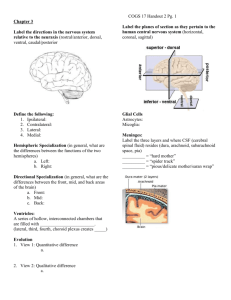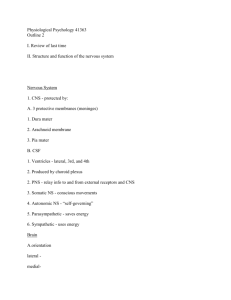Brain PPT
advertisement
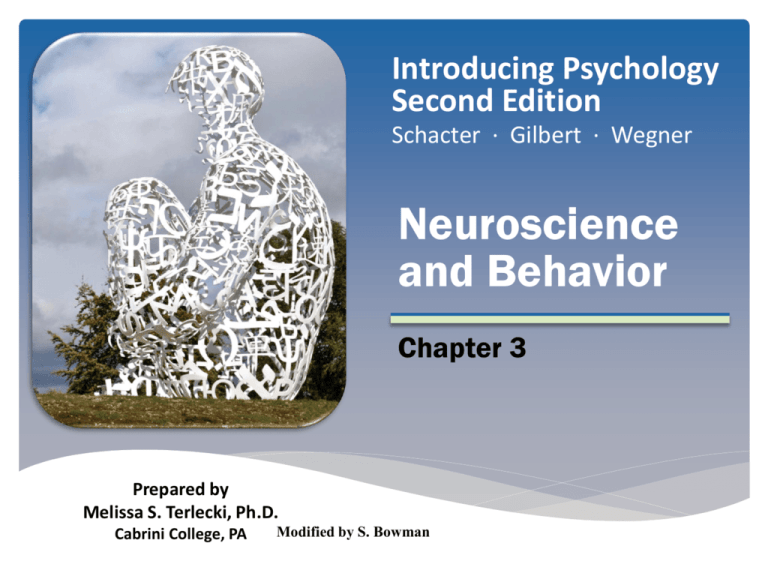
Introducing Psychology Second Edition Schacter · Gilbert · Wegner Neuroscience and Behavior Chapter 3 Prepared by Melissa S. Terlecki, Ph.D. Cabrini College, PA Modified by S. Bowman Figure 3.1 Components of a Neuron Types and Functions of Neurotransmitters *Dopamine (DA): regulates motor behavior, motivation, pleasure, and emotional arousal *Norepinephrine (NE): influences mood and arousal *Serotonin (5-HT): involved in the regulation of sleep and wakefulness, eating, and aggressive behaviors *Endorphins: act within the pain pathways and emotion centers of the brain How do neurotransmitters create the feeling of “runner’s high”? Endorphins elevate mood and dull pain. How Drugs Mimic Neurotransmitters Drugs affect the nervous system by increasing, interfering with, or mimicking neurotransmitters. Agonists: drugs that increase the action of a neurotransmitter Antagonists: drugs that block the function of a neurotransmitter Examples include: L-dopa, heroin (MPPP and MPTP), methamphetamine, amphetamine, cocaine, Prozac (SSRI), propranolol (beta-blocker) Note: L-dopa acts as an agonist for dopamine, meaning what? Figure 3.6 The Human Nervous System What triggers the increase in your heart rate when you feel threatened? Figure 3.6 The Human Nervous System Sympathetic Nervous System Figure 3.8 The Pain Withdrawal Reflex Many actions of the central nervous system don’t require the brain’s input. For example, withdrawing from pain is a reflexive activity controlled by the spinal cord. Painful sensations (such as a pin jabbing your finger) travel directly to the spinal cord via sensory neurons, which then issue an immediate command to motor neurons to retract the hand. DANIEL L. SCHACTER, DANIEL T. GILBERT, DANIEL M. WEGNER: Introducing Psychology, Second Edition Copyright © 2013, 2011 by Worth Publishers Structure of the Brain Different regions of the brain are specialized for different kinds of tasks. Simpler functions are performed at the “lower levels” and more complex functions are performed at “higher levels.” There are three major divisions of the brain: o the hindbrain o the midbrain o the forebrain Figure 3.9 The Major Divisions of the Brain an area of the brain that coordinates information coming into and out of the spinal cord, and controls the basic functions of life Medulla: an extension of the spinal cord into the skull that coordinates heart rate, circulation, and respiration o Reticular formation: a brain structure that regulates sleep, wakefulness, and levels of arousal Cerebellum: a large structure of the hindbrain that controls fine motor skills Which part of the brain helps Pons: a brain structure that to orchestrate the sequential relays information from the cerebellum to the rest of the movements that keep you brain. steady on your bike? The Hindbrain The Hindbrain Which part of the brain helps to orchestrate the sequential movements that keep you steady on your bike? The Cerebellum The Midbrain an area of the brain that is important for orientation and movement. Tectum and tegmentum: help orient an organism in the environment and guide movement toward or away from stimuli. The Forebrain is the highest level of brain; critical for complex cognitive, emotional, sensory, and motor functions. Subcortical structures: areas of the forebrain housed under the cerebral cortex near the very center of the brain. Thalamus: a subcortical structure that relays and filters information from the senses and transmits the information to the cerebral cortex. Hypothalamus: a subcortical structure that regulates body temperature, hunger, thirst, and sexual behavior. Pituitary gland: the “master gland” of the body’s hormone-producing system, which releases hormones that direct the functions of many other glands in the body. Hippocampus: a structure critical for creating new memories and integrating them into a network of knowledge so that they can be stored indefinitely in other parts of the cerebral cortex. Amygdala: a part of the limbic system that plays a central role in many emotional processes, particularly the formation of emotional memories. Basal ganglia: a set of subcortical structures that directs intentional movements. Figure 3.12 The Forebrain Which part is responsible for creating new memories and integrating them with old memories to be stored elsewhere? What is the function of the amygdala? Figure 3.12 The Forebrain Which part is responsible for creating new memories and integrating them with old memories to be stored elsewhere? The hippocampus What is the function of the amygdala? The formation of emotional memories The Cerebral Cortex Cerebral cortex: the outermost layer of the brain, divided into two hemispheres (left and right) Contralateral control means that each hemisphere controls the functions of the opposite side of the body. Corpus callosum: a thick band of nerve fibers that connects large areas of the cerebral cortex on each side of the brain and supports communication of information across the hemispheres Figure 3.14 Cerebral Cortex and Lobes Four lobes of the cortex (in each hemisphere): Occipital lobe: a region of the cerebral cortex that processes visual information Parietal lobe: a region of the cerebral cortex whose functions include processing information about touch Temporal lobe: a region of the cerebral cortex responsible for hearing and language Frontal lobe: a region of the cerebral cortex that has specialized areas for movement, abstract thinking, planning, memory, and judgment. Association areas: areas of the cerebral cortex that are composed of neurons that help provide sense and meaning to information registered in the cortex Figure 3.15 Somatosensory and Motor Cortices Figure 3.15 Somatosensory and Motor Cortices The somatosensory cortex is located in the parietal lobe. Each part maps on to a particular part of the body. The homunculus (pg. 75) illustrates how much of the cortex is devoted to certain body parts. Brain Plasticity Sensory cortices can adapt to change. The brain is “plastic”: Functions that were assigned to certain areas of the brain may be capable of being reassigned to other areas of the brain to accommodate changing input from the environment. Greater use of an area for a function may result in a larger area of cortical representations. Physical exercise can increase the number of synapses and even promote the development of new neurons in the hippocampus. Brain Plasticity and Sensations in Phantom Limbs What does it mean to say that the brain is plastic? Functions in one area may be reassigned to another. Phantom limb syndrome: Following limb amputation, some patients continue to feel sensations where the missing limb would be. Brain scans of amputees revealed that stimulating areas of the face and other parts of the body may activate sensations in the missing limb, due to compensation of cortical area in the somatosensory cortex. Researchers have used a “mirror box” to teach amputees new mapping to increase voluntary control over their phantom limbs. Evolutionary Development of the Central Nervous System (3.5) During evolution, a split in the nervous system occurred between invertebrates (animals without a spinal column) and vertebrates (animals with a spinal column). The forebrain undergoes evolutionary advances in vertebrates, reaching its peak with humans. Figure 3.16 Development of the Forebrain What is the difference in the organization of the nervous system between invertebrate and vertebrate animals? Development of the forebrain. Genes and the Environment Both nature (biology) and nurture (environment) interact to play a role in directing behavior. *Gene: the unit of hereditary transmission; sections on strands of DNA organized into chromosomes o *Chromosomes: strands of DNA wound around each other in a double-helix configuration. How many do we have? 23 Pairs. Figure 3.17 Genes, Chromosomes, and Their Recombination Monozygotic and Dizygotic Twins Degree of relatedness refers to the probability of sharing genes o Monozygotic twins share 100% of their genes. o Dizygotic twins share 50% of their genes. Twin studies attempt to separate genetics (nature) from environment (nurture). Learning About Brain Organization by Studying the Damaged Brain Much research in neuroscience correlates loss of specific functions to brain damage. Phineas Gage’s accident affected the emotional frontal lobe. Current accidents-teen and spear accident. Learning About Brain Organization by Studying the Damaged Brain The split-brain procedure used to temper intractable epilepsy severs the corpus callosum and allows the study of separate hemispheric specialization. Roger Sperry (1913-1994) designed several experiments that investigated the behaviors of split-brain patients. The left hemisphere is more responsible for language processing. Video on severed corpus callosum. Figure 3.19 Split-Brain Experiment Listening to the Brain Single Neurons and Global Activity The link between brain structures and behavior can be studied through the recording of electrical activity in neurons. Electroencephalograph (EEG): a device used to record electrical activity in the brain. Electrodes are placed on the outside of the head. David Hubel (1926-) and Torsten Wiesel (1924-) inserted Figure 3.20 electrodes into the brains of EEG anesthetized cats, which led to the discovery of visual feature detectors. How does the EEG record electrical activity in the brain? Brain Imaging From Visualizing Structure to Watching the Brain in Action Figure 3.21 Structural Imaging Techniques (CT and MRI) Neuroimaging techniques use advanced technology to create images of the living, healthy brain. Structural brain imaging shows underlying brain structure. o Computerized axial tomography (CT) scan and magnetic resonance imaging (MRI) are examples. Brain Imaging From Visualizing Structure to Watching the Brain in Action Functional brain imaging shows brain activity while someone engages in a cognitive or motor task. Positron emission tomography (PET) and functional magnetic resonance imaging (fMRI) are examples. o fMRI shows the fusiform gyrus to be responsible for the recognition of faces. What does an fMRI track in an active brain? Figure 3.22 Functional Imaging Techniques (PET and fMRI) Where Do You Stand? Brain Death Brain death is defined as the irreversible loss of all functions of the brain. o A flat-line EEG does not indicate that all brain functions have stopped. Terri Schiavo (2005) was kept alive on a respirator and feeding tube for nearly 15 years. o She was brain-dead, or in a persistent vegetative state. o There was controversy over her level of consciousness and voluntary behavior. Who/how should we decide whether someone is really “alive”?


